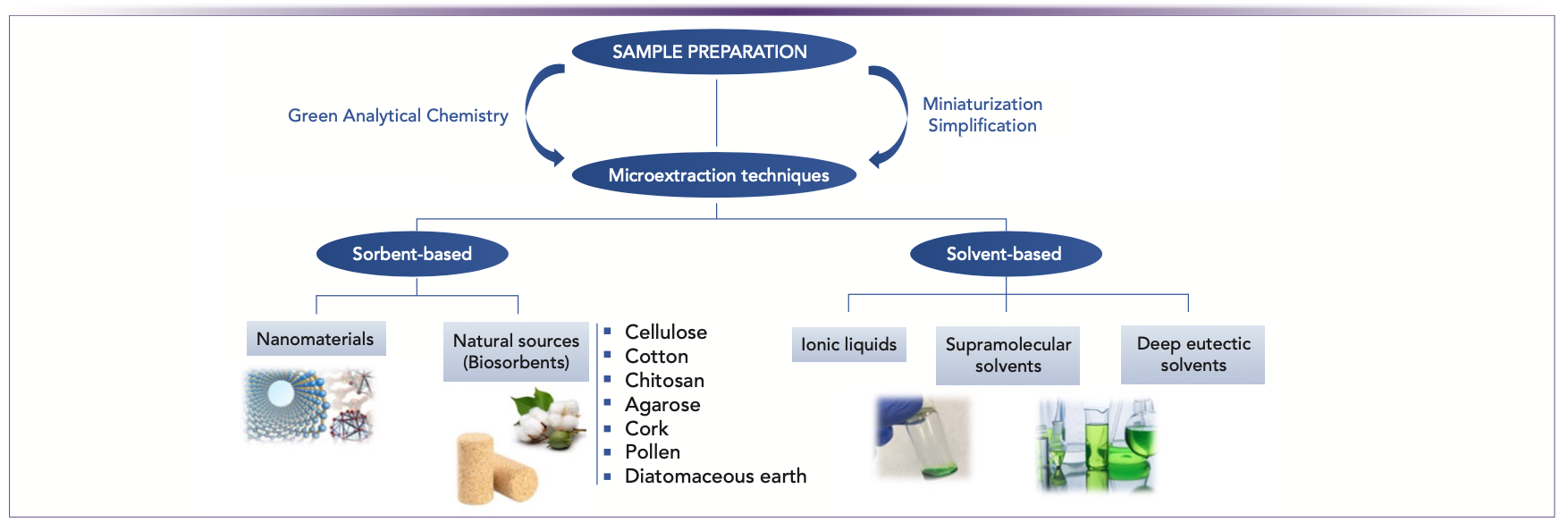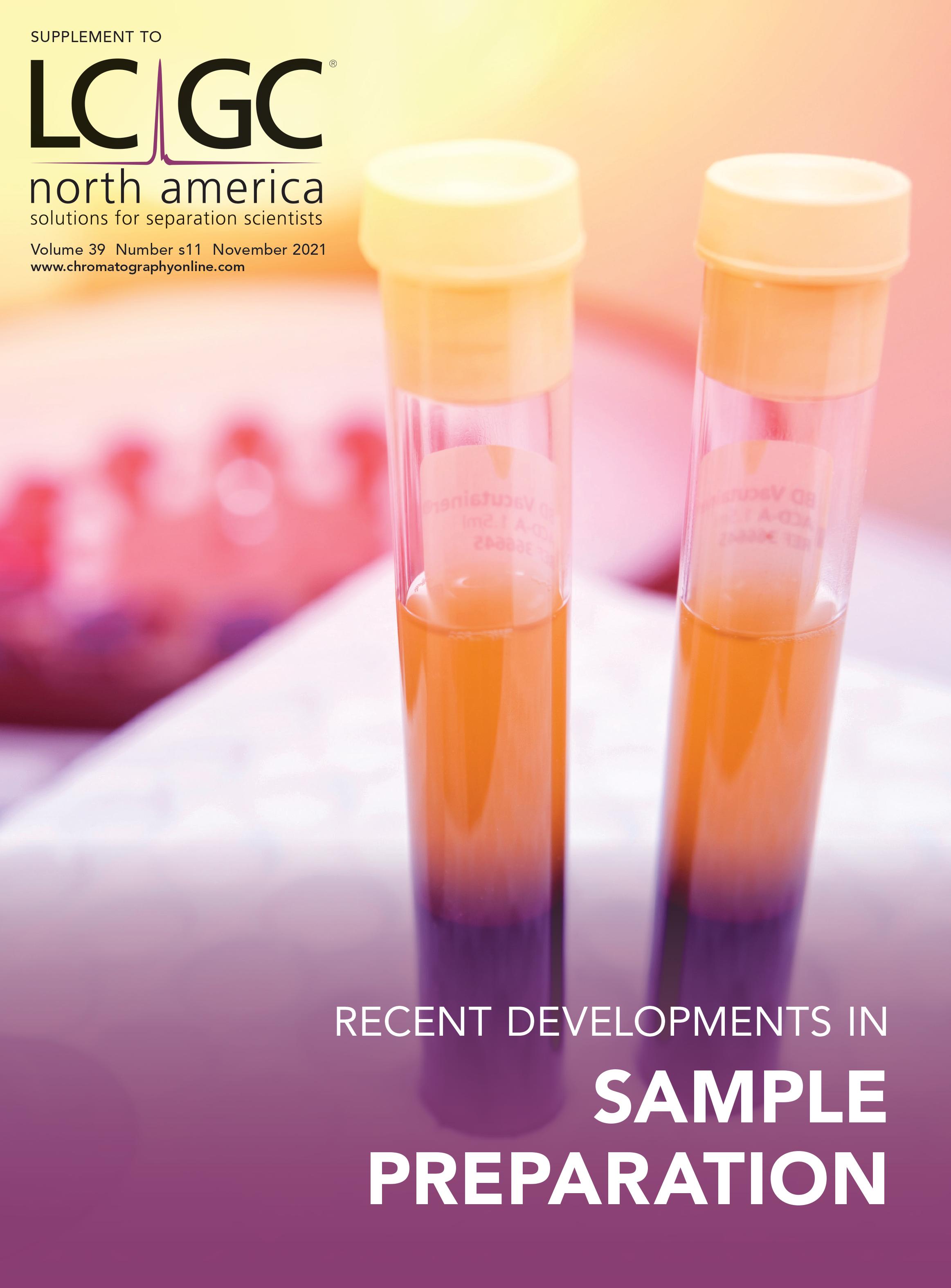Moving Toward Green and Sustainable Sample Preparation
The sample preparation field is changing to adjust to the current trends in Green Analytical Chemistry (GAC) principles and adapt to application requirements. Specifically, microextraction techniques have evolved since their appearance three decades ago, moving towards the use of greener and sustainable materials and solvents. This article highlights the main advances in this field, emphasizing their properties and improvements, and elucidates the reason for this trend.
Sample preparation is one of the hot topics within the field of analytical chemistry because it involves conditioning the sample to the requirements for its analysis. This stage becomes more relevant when it is used to isolate the target analytes from a complex matrix or from interfering compounds, or to preconcentrate them.
The desired sensitivity and selectivity achieved by a particular sample preparation methodology is often a primary reason for its selection. However, beyond these analytical features, there are other practical factors to consider when selecting or developing a method, especially those that need to be aligned with the current trends of Green Analytical Chemistry (GAC) (1) and the recently proposed White Analytical Chemistry (WAC) (2) principles. Some of these essential key highlights of the analytical strategy are the reduction of resources (that is, sample amount, chemicals, and organic solvents), waste, and energy consumption, as well as the speed, ease of handling, and cost-effectiveness, among others (3). Thus, the simplification and sustainability of a particular sample preparation method is one of the axes in which the analytical scientific community has turned in recent decades to reduce the impact of analytical methodologies on the environment.
Bearing these guidelines in mind, microextraction techniques have emerged as successful alternatives to traditional extraction techniques, such as solid-phase extraction (SPE) and liquid–liquid extraction (LLE), in which the required sample volume, the solvent consumption, and the cost are all reduced. More specifically, the first miniaturization of SPE resulted in solid-phase microextraction (SPME), presented by Arthur and Pawliszyn in 1990, and since then, numerous techniques have been developed, both in solid- and liquid-phase depending on the nature of the extraction phase.
Despite their appearance about 30 years ago, microextraction approaches have not diminished or have been replaced. Instead, they have evolved, moving towards the design, synthesis, and application of greener and sustainable sorbents (in the case of sorbent-based microextraction techniques) and solvents (in the case of solvent-based microextraction techniques), all of them with interesting and effective extraction properties. This trend is one of the areas of greatest interest today by researchers across the globe and has paved the way for sample preparation in the coming years.
Sorbent-Based Microextraction Approaches
The use of nanomaterials as extraction phases in sorbent-based micro-extraction approaches is making a significant impact today. They have attracted attention because of a number of reasons including their high surface area compared to macroscale materials, their thermal and chemical stability, and their easy surface modification that allows the synthesis of tailor-made sorbents and thus increased selectivity towards target analytes. In this context, metal or metal oxide nanoparticles, carbonaceous materials (carbon nanotubes, graphene), metal-organic frameworks, molecularly imprinted polymers, or layered-double hydroxides, are some examples of these commonly used nanomaterials. More recently, magnetic nanomaterials occupy an important place in the microextraction applications mainly because of their easy retrieval after extraction by means of an external magnetic field, reducing sample pretreatment time and simplifying the entire procedure (4). Likewise, the possibility of reusing and recycling these materials in different extraction procedures provides them an additional green feature, which fulfill the guidelines of GAC.
However, it should be noted that even though the resulting material can be considered ecological, most of these sorbents are synthetic. Therefore, their synthesis in the laboratory may be associated with the consumption of organic solvents or hazardous reagents, or may involve several stages. For this reason, there has been a growing effort in recent years to use sorbent materials obtained from natural sources (5). These so-called “biosorbents” or “biopolymers”, which also possess an excellent extraction capacity comparable to synthetic materials, are sustainable and biodegradable, and proceed from living organisms. In this sense, different polysaccharides, such as cellulose, cotton, chitin and its derivative chitosan, and agarose, have been used as natural sorbents in sorbent-based microextraction approaches for the determination of ions and organic compounds in a variety of complex matrices (6). Along with the growing concern for greener methods, other natural, biodegradable, and renewable materials, such as cork, pollen, or diatomaceous earth, have also caught the interest of researchers for use as extraction phases that can replace synthetic ones (7). In all of these cases, it is possible to modify these natural sorbents, or even combine them with other nanomaterials from those described above, to enhance the selectivity of the extraction and the reactivity of the material. However, this combination causes the greenness of the resulting material to decrease because of the use of other reagents or solvents during their preparation, and the necessity of additional instrumentation and energy consumption.
Solvent-Based Microextraction Approaches
Solvent-based microextraction techniques were introduced in the mid-1990s as a miniaturization of the classical LLE. The extraction usually takes place between an aqueous donor phase containing the analytes and an immiscible organic solvent acting as the extraction phase. The small volume of extraction solvent used in these approaches, typically only a few microliters, is one of the advantages, but its nature also must be considered to fulfill GAC guidelines. Traditionally, conventional organic solvents (toluene or 1-octanol), and halogenated ones such as chloroform or dichloromethane, were among the solvents first used in these early applications. However, despite the good results obtained from their use, it is well known that these solvents have a marked toxicity, and they are not environmentally friendly.
In the past few years, researchers have investigated alternative biodegradable, less toxic, and easy to prepare solvents (8). As a first alternative, researchers explored ionic liquids, such as negligible vapor pressure, tailorable properties, and non-flammability, because they were considered in most of the solvent-based microextraction approaches as extraction solvents. Nevertheless, ionic liquids were not entirely compatible with chromatographic systems, and their synthesis includes toxic reagents, and thus they cannot be considered environmentally friendly. For that reason, other alternatives have emerged for the last years. In this context, supramolecular solvents (SUPRAs) and deep eutectic solvents (DESs) are among the most relevant examples, as illustrated in the increase of applications making use of these solvents in different solvent-based microextraction modalities (9). SUPRAs can be synthesized in situ and does not require additional steps to be introduced in most analytical instruments, whereas DESs are prepared by simply mixing low-toxicity reagents and solvents, sometimes coming from “natural” precursors. However, their viscosity can prevent their direct coupling with some analytical instrumentation, especially chromatographic measurements, without carrying out a pre-dilution or back-extraction. Thus, the search for ideal green solvents featuring great extraction capability and harmless synthesis and handling is still a key aspect that researchers must continue to focus on.
Conclusions
Since the beginning of microextraction techniques, there has been awareness of the materials used as the extraction phase. Future research will continue with the development of new materials, and the expansion of the application of those already in use, always keeping in mind the principles of GAC (Figure 1). In this sense, the toxicity and environmental impact of many of these new materials still need to be evaluated to ensure compliance with the GAC principles that currently govern the field of sample preparation. In any case, given the promising results provided by these greener sorbents and solvents compared to the traditional ones, and the growing research into their synthesis, it is expected that the number of methodologies using such materials will increase over the next years, resulting in advances in sample preparation.
FIGURE 1: Overview of green materials in microextraction techniques.

Acknowledgments
Financial support from the Spanish Ministry of Science and Innovation (PID2020-118924RB-I00) is gratefully acknowledged. The authors also thank the Spanish Ministry of Education and Vocational Training for the predoctoral grant of Cristian Azorín and the Generalitat Valenciana and the European Social Fund for the predoctoral and postdoctoral grant of Víctor Vállez-Gomis and Juan L. Benedé, respectively. This article is based upon work from the National Thematic Network on Sample Treatment (RED-2018-102522-T) of the Spanish Ministry of Science, Innovation and Universities, and the Sample Preparation Study Group and Network supported by the Division of Analytical Chemistry of the European Chemical Society.
References
(1) A. Gałuszka, Z. Migaszewski, and J. Namieśnik, Trends Anal. Chem. 50, 78–84 (2013). DOI: 10.1016/j. trac.2013.04.010
(2) P.M. Nowak, R. Wietecha-Posłuszny, and J. Pawliszyn, Trends Anal. Chem. 138, 116223 (2021). DOI: 10.1016/j.trac.2021.116223
(3) A. Chisvert, J. Chrom. Sep. Tech. 3, 1000e111 (2012). DOI: 10.4172/2157-7064.1000e111
(4) M. Faraji, M. Shirani, and H. Rashidi-Nodeh, Trends Anal. Chem. 141, 116302 (2021). DOI: 10.1016/j.trac.2021.116302
(5) N.H. Godage and E. Gionfriddo, Anal. Chim. Acta. 1125, 187–200 (2020). DOI: 10.1016/j.aca.2020.05.045
(6) I. Pacheco-Fernández, D.W. Allgaier-Díaz, G. Mastellone, C. Cagliero, D. Díaz-Díaz, and V. Pino, Trends Anal. Chem. 125, 115839 (2020). DOI: 10.1016/j.trac.2020.115839
(7) G. Mafra, M.T. García-Valverde, J. Millán-Santiago, E. Carasek, R. Lucena, and S. Cárdenas, Separations 7, 2 (2020). DOI: 10.3390/separations7010002
(8) E. Carasek, G. Bernardia, D. Morellia, and J. Merib, J. Chromatogr. A 1640, 461944 (2021). DOI: 10.1016/j.chroma.2021.461944
(9) J. Grau, C. Azorín, J.L. Benedé, A. Chisvert, and A. Salvador, J. Sep. Sci. (2021). DOI: 10.1002/jssc.202100609
Juan L. Benedé, Alberto Chisvert, José Grau, Víctor Vállez-Gomis, Cristian Azorín, Lorenza Schettino, Guillem Peris-Pastor, and Amparo Salvador are with the GICAPC Research group in the Department of Analytical Chemistry at the University of Valencia, in Valencia, Spain. Direct correspondence to: benede@uv.es.

University of Rouen-Normandy Scientists Explore Eco-Friendly Sampling Approach for GC-HRMS
April 17th 2025Root exudates—substances secreted by living plant roots—are challenging to sample, as they are typically extracted using artificial devices and can vary widely in both quantity and composition across plant species.

.png&w=3840&q=75)

.png&w=3840&q=75)



.png&w=3840&q=75)



.png&w=3840&q=75)










